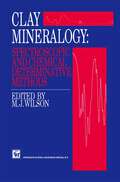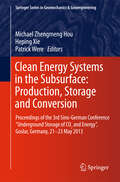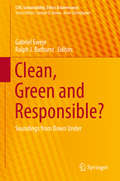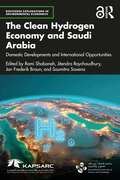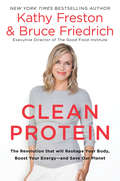- Table View
- List View
Classification Methods for Remotely Sensed Data
by Paul M. Mather Taskin Kavzoglu Brandt TsoThe third edition of the bestselling Classification Methods for Remotely Sensed Data covers current state-of-the-art machine learning algorithms and developments in the analysis of remotely sensed data. This book is thoroughly updated to meet the needs of readers today and provides six new chapters on deep learning, feature extraction and selection, multisource image fusion, hyperparameter optimization, accuracy assessment with model explainability, and object-based image analysis, which is relatively a new paradigm in image processing and classification. It presents new AI-based analysis tools and metrics together with ongoing debates on accuracy assessment strategies and XAI methods.New in this edition: Provides comprehensive background on the theory of deep learning and its application to remote sensing data. Includes a chapter on hyperparameter optimization techniques to guarantee the highest performance in classification applications. Outlines the latest strategies and accuracy measures in accuracy assessment and summarizes accuracy metrics and assessment strategies. Discusses the methods used for explaining inherent structures and weighing the features of ML and AI algorithms that are critical for explaining the robustness of the models. This book is intended for industry professionals, researchers, academics, and graduate students who want a thorough and up-to-date guide to the many and varied techniques of image classification applied in the fields of geography, geospatial and earth sciences, electronic and computer science, environmental engineering, etc.
Classification Methods for Remotely Sensed Data
by Paul M. Mather Taskin Kavzoglu Brandt TsoThe third edition of the bestselling Classification Methods for Remotely Sensed Data covers current state-of-the-art machine learning algorithms and developments in the analysis of remotely sensed data. This book is thoroughly updated to meet the needs of readers today and provides six new chapters on deep learning, feature extraction and selection, multisource image fusion, hyperparameter optimization, accuracy assessment with model explainability, and object-based image analysis, which is relatively a new paradigm in image processing and classification. It presents new AI-based analysis tools and metrics together with ongoing debates on accuracy assessment strategies and XAI methods.New in this edition: Provides comprehensive background on the theory of deep learning and its application to remote sensing data. Includes a chapter on hyperparameter optimization techniques to guarantee the highest performance in classification applications. Outlines the latest strategies and accuracy measures in accuracy assessment and summarizes accuracy metrics and assessment strategies. Discusses the methods used for explaining inherent structures and weighing the features of ML and AI algorithms that are critical for explaining the robustness of the models. This book is intended for industry professionals, researchers, academics, and graduate students who want a thorough and up-to-date guide to the many and varied techniques of image classification applied in the fields of geography, geospatial and earth sciences, electronic and computer science, environmental engineering, etc.
Classification of Nuclear C*-Algebras. Entropy in Operator Algebras (Encyclopaedia of Mathematical Sciences #126)
by M. Rordam E. Stormerto the Encyclopaedia Subseries on Operator Algebras and Non-Commutative Geometry The theory of von Neumann algebras was initiated in a series of papers by Murray and von Neumann in the 1930's and 1940's. A von Neumann algebra is a self-adjoint unital subalgebra M of the algebra of bounded operators of a Hilbert space which is closed in the weak operator topology. According to von Neumann's bicommutant theorem, M is closed in the weak operator topology if and only if it is equal to the commutant of its commutant. Afactor is a von Neumann algebra with trivial centre and the work of Murray and von Neumann contained a reduction of all von Neumann algebras to factors and a classification of factors into types I, II and III. C* -algebras are self-adjoint operator algebras on Hilbert space which are closed in the norm topology. Their study was begun in the work of Gelfand and Naimark who showed that such algebras can be characterized abstractly as involutive Banach algebras, satisfying an algebraic relation connecting the norm and the involution. They also obtained the fundamental result that a commutative unital C* -algebra is isomorphic to the algebra of complex valued continuous functions on a compact space - its spectrum. Since then the subject of operator algebras has evolved into a huge mathematical endeavour interacting with almost every branch of mathematics and several areas of theoretical physics.
Clastic Hydrocarbon Reservoir Sedimentology (Advances in Oil and Gas Exploration & Production)
by Xinghe Yu Shengli Li Shunli LiThis book presents a comprehensive assessment of clastic sedimentology and its application to reservoir geology. It covers the theoretical foundations of the topic and its use for scientists as well as professionals in the field. Further, it addresses all aspects of reservoir sedimentology, clastic sequence stratigraphy, sedimentation, reservoir diagenesis and heterogeneity, as well as depositional systems (alluvial, fluvial, lacustrine, delta, sandy coast, neritic, deep-water) in detail.The research team responsible for this book has been investigating clastic sedimentology for more than three decades and consists of highly published and cited authors. The Chinese edition of this book has been a great success, and is popular among sedimentologists and petroleum geologists alike.
Claxton: Field Notes from a Small Planet
by Mark Cocker'After Mark Cocker’s glorious book, you will never look at a blackberry bush the same way again.' Philip Hoare, New Statesman In 2001 Mark Cocker moved to Claxton, a small village in Norfolk. In a series of daily writings spanning the course of a year he explores his relationship to the landscape he lives in, to nature and to all the living things around him - the birds, plants, trees, mammals, hoverflies, moths, butterflies, bush crickets, grasshoppers, ants and bumblebees. Passionate, astonishing and inspiring, this book is a celebration of the wonder that lies in our everyday experience.Shortlisted for the Royal Society of Biology Book Award, the Jarrold East Anglian Book Awards, the New Angle Prize and theThwaites Wainwright Prize
Clay Microstructure (Geological Sciences Series)
by Richard Bennett Matthew HulbertPlan of Review This review of clay microstructure is aimed at the diverse group of professionals who share an interest in the properties of fine-grained minerals in sediments. During the last several decades, members of this group have included geologists, soil scientists, soil engineers, engineering geologists, and ceramics scientists. More recently, it has included significant numbers of marine geologists and other engineers. Each of the disciplines has developed special techniques for investigating properties of clay sediments that have proven to be fruitful in answering questions of central interest. Knowledge of clay microstructure-the fabric of a sediment and the physico chemical interactions between its components-is fundamental to all these disciplines (Mitchell 1956; Lambe 1958a; Foster and De 1971). Clay fabric refers to the spatial distribution, orientations, and particle-to-particle relations of the solid particles (generally those less than 3. 9 /Lm in size) of sediment. Physico-chemical interac tions are expressions of the forces between the particles. In this review, we trace the historical development of under standing clay microstructure by discussing key scientific papers published before 1986 on physico-chemical interactions in fine grained sediments and on clay fabric. Since the development follows an intricate path, the current view of clay microstructure is summarized. This summary includes a discussion of the present state of knowledge, the observations made so far, and the facts that are now established.
Clay Mineral Cements in Sandstones (International Association Of Sedimentologists Series #19)
by Richard Worden Sadoon MoradClay minerals are one of the most important groups of minerals that destroy permeability in sandstones. However, they also react with drilling and completion fluids and induce fines migration during hydrocarbon production. They are a very complex family of minerals that are routinely intergrown with each other, contain a wide range of solid solutions and form by a variety of processes under a wide range temperatures and rock and fluid compositions. In this volume, clay minerals in sandstones are reviewed in terms of their mineralogy and general occurrence, their stable and radiogenic isotope geochemistry, XRD quantification, their effects on the petrophysical properties of sandstones and their relationships to sequence stratigraphy and palaeoclimate. The controls on various clay minerals are addressed and a variety of geochemical issues, including the importance of mass flux, links to carbonate mineral diagenesis and linked clay mineral diagenesis in interbedded mudstone-sandstone are explored. A number of case studies are included for kaolin, illite and chlorite cements, and the occurrence of smectite in sandstone is reviewed. Experimental rate data for clay cements in sandstones are reviewed and there are two model-based case studies that address the rates of growth of kaolinite and illite. The readership of this volume will include sedimentologists and petrographers who deal with the occurrence, spatial and temporal distribution patterns and importance of clay mineral cements in sandstones, geochemists involved in unraveling the factors that control clay mineral cement formation in sandstones and petroleum geoscientists involved in predicting clay mineral distribution in sandstones. The book will also be of interest to geologists involved in palaeoclimate studies basin analysis. Latest geochemical data on clays in sandstones Provides important information for geologists involved in basin analysis, sandstone petrology and petroleum geology If you are a member of the International Association of Sedimentologists (IAS), for purchasing details, please see: http://www.iasnet.org/publications/details.asp?code=SP34
Clay Mineralogy: Spectroscopic and Chemical Determinative Methods
by M. J. WilsonA knowledge of clay is important in many spheres of scientific endeav our, particularly in natural sciences such as geology, mineralogy and soil science, but also in more applied areas like environmental and mater ials science. Over the last two decades research into clay mineralogy has been strongly influenced by the development and application of a num ber of spectroscopic techniques which are now able to yield information about clay materials at a level of detail that previously would have seemed inconceivable. This information relates not only to the precise characterization of the individual clay components themselves, but also to the ways in which these components interact with a whole range of absorbate molecules. At present, however, the fruits of this research are to be found principally in a somewhat widely dispersed form in the scientific journals, and it was thus considered to be an appropriate time to bring together a compilation of these spectroscopic techniques in a way which would make them more accessible to the non-specialist. This is the primary aim of this book. The authors of the various chapters first describe the principles and instrumentation of the individual spectro scopic techniques, assuming a minimum of prior knowledge, and then go on to show how these methods have been usefully applied to clay mineralogy in its broadest context.
Clay Minerals: Their Antimicrobial and Antitoxic Applications
by Bhaskar Ghosh Dola ChakrabortyThis book provides a comprehensive description of the application of clay minerals as disinfectants and the ingredients of medicines. While the presently available literature highlights one or two aspects of medicinal clays, a comprehensive text on all their major pharmaceutical applications is lacking. This book endeavors to fill up this lacuna. It further elucidates the properties of clay minerals that facilitate their application in the protection of human health, and how these properties are related to the chemical compositions and internal structures of selected mineral groups, thus revealing to the students, teachers and researchers the underlying relationship of seemingly different disciplines like mineralogy, material science and medical science. The thought-provoking questions added at the end of each chapter will give the readers a better insight of this subject. The tangible definitions and explanations of all the relevant scientific terms provided in this book, both within the text and in a glossary list at the end, are expected to help the beginners to develop a clear-cut understanding regarding different aspects of the subject and clear any confusion resulting from the ambiguous usage of terms in the existing literature.
Clay Sedimentology
by Herve ChamleyClay Sedimentology is a comprehensive textbook divided into six parts: - clay minerals and weathering - clay sedimentation on land - origin and behaviour of clay minerals and associated minerals in transitional environments (estuaries, deltas) and shallow-sea environments - diverse origins of clay in the marine environment - post-sedimentary processes intervening during early and late diagenesis - use of clay stratigraphic data for the reconstruction of past climate, marine circulation, tectonics, and other paleogeographical aspects. A basic idea on most topics dealing with sedimentary clays is presented and controversial data and uncertainties from the frontiers of knowledge are discussed.
Clays
by Alain MeunierHere is a comprehensive and up to-do-date presentation of the origins, and properties of clay minerals at the Earth´s surface. The text reviews the relatively simple laws that govern the chemical or isotopic composition and the crystalline structure of clays, and then discusses their genesis and alteration. Concluding chapters show that clay minerals can form in variety of different environments: meteorites, lavas, subduction zones, among others.
Clays and Health: Properties and Therapeutic Uses
by Michel Rautureau Celso de Figueiredo Gomes Nicole Liewig Mehrnaz Katouzian-SafadiOriginally published in French, this updated and expanded English translation offers a definitive treatment on clays and effects on human health including the long history of clays used as pharmaceutical and therapeutic agents, the origins of clays, their structural properties and modes of action.
Clays in Crustal Environments: Isotope Dating and Tracing
by Norbert Clauer Sambhu ChaudhuriClay minerals form in a wide variety of crustal environments, e.g. in soil profiles, in sediments at the surface and in deeply buried sedimentary deposits, and under regional, contact and hydrothermal metamorphism conditions.The book provides information about the dynamics of isotope systems in clays and helps us to understand the physical and chemical parameters in the transfer of masses within the crustal domain. Written for graduate students taking courses in sedimentary geochemistry, clay mineralogy, and soil mineralogy, the book will also appeal to scientists carrying out research on clay genesis and mass transfer in crustal environments.
Clean: Lessons from Ecolab's Century of Positive Impact
by Paul C. Godfrey Emilio R. TenutaStraightforward strategies for achieving sustainable practices and business success in the modern organization In Clean: Lessons from Ecolab’s Century of Positive Impact, a team of veteran sustainability experts delivers a practical toolkit for creating a forward-looking and sustainability-focused business. From Ecolab’s origins in sustainability 100 years ago to its ambitious 2030 environment and social impact goals, this book lays out a roadmap for business transformation and continued growth – today and for the next 100 years. You’ll explore the principles and methods required to build and lead a sustainable company. You’ll discover how to evolve your focus on sustainability over time, as your organization transforms and grows. You’ll learn to: Build and maintain momentum for sustainability initiatives and cement your firm’s commitment to new practices through iteration and aligning business units around core, shared sustainability goals. Embed new sustainable practices into your organization’s governance and operations DNA Identify and leverage specific sustainability levers that impact a wide variety of key performance indicators Create a set of business processes that enable sustainable future and engage your employees in a higher purposeAn essential playbook for students of sustainability and business, this book is a must-read for the modern manager, executive, or director seeking to solidify their business strategy and future-proof their company. Clean: Lessons from Ecolab’s Century of Positive Impact describes the holistic and comprehensive approach to responsible business that we’ve all been waiting for.
Clean: Lessons from Ecolab's Century of Positive Impact
by Paul C. Godfrey Emilio R. TenutaStraightforward strategies for achieving sustainable practices and business success in the modern organization In Clean: Lessons from Ecolab’s Century of Positive Impact, a team of veteran sustainability experts delivers a practical toolkit for creating a forward-looking and sustainability-focused business. From Ecolab’s origins in sustainability 100 years ago to its ambitious 2030 environment and social impact goals, this book lays out a roadmap for business transformation and continued growth – today and for the next 100 years. You’ll explore the principles and methods required to build and lead a sustainable company. You’ll discover how to evolve your focus on sustainability over time, as your organization transforms and grows. You’ll learn to: Build and maintain momentum for sustainability initiatives and cement your firm’s commitment to new practices through iteration and aligning business units around core, shared sustainability goals. Embed new sustainable practices into your organization’s governance and operations DNA Identify and leverage specific sustainability levers that impact a wide variety of key performance indicators Create a set of business processes that enable sustainable future and engage your employees in a higher purposeAn essential playbook for students of sustainability and business, this book is a must-read for the modern manager, executive, or director seeking to solidify their business strategy and future-proof their company. Clean: Lessons from Ecolab’s Century of Positive Impact describes the holistic and comprehensive approach to responsible business that we’ve all been waiting for.
CLEAN: CO2 Large-Scale Enhanced Gas Recovery in the Altmark Natural Gas Field - GEOTECHNOLOGIEN Science Report No. 19 (Advanced Technologies in Earth Sciences)
by Michael Kühn Ute MünchThe project CLEAN (CO2 Large-Scale Enhanced Gas Recovery in the Altmark Natural Gas Field) provides site specific knowledge for a potential future pilot project. This contributed volume gives an overview and final results of the entire project which is finalized to the end of 2012.
Clean and Sustainable Groundwater in India (Springer Hydrogeology)
by Dipankar Saha Sanjay Marwaha Arunangshu MukherjeeThe book embodies the groundwater issues and challenges in India focusing its sustainable use. It is a compilation of papers presented by the eminent experts from Government departments, academia, research institutes, NGOs and stakeholders who assembled at Kurukshetra on 21st August, 2015 in the event of Bhujal Manthan or “Churning of Groundwater” organized for the first time by Ministry of Water Resources, River Development and Ganga Rejuvenation, the apex Ministry of Water Resource under Government of India.India, as a country, is the highest groundwater extractor in the world. Its service towards attaining the food and clean drinking water security is well documented. This volume addresses the issues of aquifer characterization, groundwater contamination, groundwater resource availability and its sustainable management through community participation in pan-India scenario. This book provides a unique opportunity for its readers to understand groundwater domain in India in its entire gamut. The papers included in the volume were selected carefully from the presentations made in the following four broad topics during the Manthan; (i) groundwater quality, (ii) conjunctive use of surface and groundwater, (iii) management intervention and sustainable use of this resource, and (iv) groundwater problems and application of various techniques. The book contains 20 papers including an introductory chapter by the editors. The content of the book is enriched by contributions from eminent researchers and activists in groundwater domain, like Prof. Tushar Shah, Prof. Himanshu Kulkarni, Dr. D. K. Chadha, Dr. Bharat Sharma and others. The recommendations in the individual papers are of immense significance for keeping the groundwater of the country clean and sustainable. The volume will help the readers to understand the groundwater issues of the country and also assist policy makers to prepare strategies for its better governance and management with environmentally sustainable ways.
Clean Energy Systems in the Subsurface: Proceedings of the 3rd Sino-German Conference “Underground Storage of CO2 and Energy”, Goslar, Germany, 21-23 May 2013 (Springer Series in Geomechanics and Geoengineering)
by Patrick Were Michael Z. Hou Heping XieAnthropogenic greenhouse gas emissions, energy security and sustainability are three of the greatest contemporary global challenges today. This year the Sino-German Cooperation Group “Underground Storage of CO2 and Energy”, is meeting on the 21-23 May 2013 for the second time in Goslar, Germany, to convene its 3rd Sino-German conference on the theme “Clean Energy Systems in the Subsurface: Production, Storage and Conversion”. This volume is a collection of diverse quality scientific works from different perspectives elucidating on the current developments in CO2 geologic sequestration research to reduce greenhouse emissions including measures to monitor surface leakage, groundwater quality and the integrity of caprock, while ensuring a sufficient supply of clean energy. The contributions herein have been structured into 6 major thematic research themes: Integrated Energy and Environmental Utilization of Geo-reservoirs: Law, Risk Management & MonitoringCO2 for Enhanced Gas and Oil Recovery, Coal Bedded Methane and Geothermal SystemsTrapping Mechanisms and Multi-Barrier Sealing Systems for Long-Term CO2 StorageCoupled THMC-Processes and Numerical ModellingRock Mechanical Behaviour Considering Cyclic Loading, Dilatancy, Damage, Self-sealing and HealingUnderground Storage and Supply of Energy“Clean energy systems in the subsurface” will be invaluable to researchers, scientists and experts in both academia and industry trying to find a long lasting solution to the problems of global climate change, energy security and sustainability.
Clean & Green: 101 Hints and Tips for a More Eco-Friendly Home
by Nancy BirtwhistleSimple swaps and innovative ideas for cleaning and maintaining your home that won't cost the Earth. Learn how easy it is to make simple swaps in your cleaning and tidying methods for a more eco-friendly home.This beautifully illustrated black and white guide with 101 hints and sustainable, natural cleaning tips and hacks will help you take small steps that have a massive positive environmental impact. In Clean & Green, Nancy Birtwhistle shares the simple recipes and methods she has developed since making a conscious effort to live more sustainably, many of which are faster and easier than the go-to products and methods most of us use now.From everyday cleaning and laundry tips to zero-effort oven cleaner and guidance on removing tricky stains from clothing and furniture, these economical, practical methods are perfect for anyone looking to reduce their use of plastic and throwaway products. Nancy shares her tried-and-tested recipes for all-purpose cleaners, replacements for harmful chemicals that will keep both your home and the planet clean and green for future generations.
Clean, Green and Responsible?: Soundings from Down Under (CSR, Sustainability, Ethics & Governance)
by Gabriel Eweje Ralph J. BathurstNew Zealand and Australia are broadly considered to be countries in which sustainability and responsibility discourses are being pursued by governments and business alike, and in which incentives and initiatives are helping confront and overcome sustainability-related challenges. This book takes a closer look behind and beyond the marketing mantras of both Australia’s and New Zealand’s “clean and green” campaigns and, on the basis of representative examples and cases, critically evaluates the status quo.The book assesses the effectiveness of sustainability and responsibility models with a focus on the South Pacific and argues that the ways in which issues have been dealt with in this more closely defined geographical region are most likely a good indicator of how similar issues are (or soon will be) dealt with around the globe. As such, the book offers a rich source of cases on sustainability and responsibility in the business arena, a critical review, and an inspirational affirmation of responsible business practice.
The Clean Hydrogen Economy and Saudi Arabia: Domestic Developments and International Opportunities (Routledge Explorations in Environmental Economics)
by Rami Shabaneh Jitendra Roychoudhury Jan Frederik Braun Saumitra SaxenaThis book provides a first-of-its-kind analysis of the emerging global hydrogen economy from the vantage point of one of the world’s biggest energy providers: Saudi Arabia. In 2021, and within the context of the Circular Carbon Economy framework, Saudi Arabia announced its goal to reach net-zero carbon emissions by 2060 and produce a substantial amount of clean hydrogen annually by 2030. The Kingdom is optimally situated geographically between the major demand markets in Europe and North Asia, from where it can leverage clean hydrogen exports as a potential tool to become a player of strategic importance and successfully diversify its economy under its Vision 2030 program. More broadly, the book charts a course for fossil fuel-exporting countries such as Saudi Arabia to carve a competitive position for themselves over the forthcoming decades using clean hydrogen as a catalyst for the energy transition.With contributions from global energy experts, the chapters in this book provide a multifaceted analysis of the "who," "what," "where," and "why" related to clean hydrogen development within and beyond Saudi Arabia. Collectively, the contributions analyze the countries and regions relevant to Saudi Arabia in terms of dedicated hydrogen policies, projects, and approaches that aim to incentivize production and demand in an increasingly carbon-constrained world. The book is a timely, unique and an indispensable resource for practitioners and students of energy, geopolitics, and climate policy working on hydrogen in academia, applied research, national government bodies, and international organizations.
The Clean Hydrogen Economy and Saudi Arabia: Domestic Developments and International Opportunities (Routledge Explorations in Environmental Economics)
This book provides a first-of-its-kind analysis of the emerging global hydrogen economy from the vantage point of one of the world’s biggest energy providers: Saudi Arabia. In 2021, and within the context of the Circular Carbon Economy framework, Saudi Arabia announced its goal to reach net-zero carbon emissions by 2060 and produce a substantial amount of clean hydrogen annually by 2030. The Kingdom is optimally situated geographically between the major demand markets in Europe and North Asia, from where it can leverage clean hydrogen exports as a potential tool to become a player of strategic importance and successfully diversify its economy under its Vision 2030 program. More broadly, the book charts a course for fossil fuel-exporting countries such as Saudi Arabia to carve a competitive position for themselves over the forthcoming decades using clean hydrogen as a catalyst for the energy transition.With contributions from global energy experts, the chapters in this book provide a multifaceted analysis of the "who," "what," "where," and "why" related to clean hydrogen development within and beyond Saudi Arabia. Collectively, the contributions analyze the countries and regions relevant to Saudi Arabia in terms of dedicated hydrogen policies, projects, and approaches that aim to incentivize production and demand in an increasingly carbon-constrained world. The book is a timely, unique and an indispensable resource for practitioners and students of energy, geopolitics, and climate policy working on hydrogen in academia, applied research, national government bodies, and international organizations.
Clean Protein: The Revolution that Will Reshape Your Body, Boost Your Energy-and Save Our Planet
by Kathy Freston Bruce FriedrichJoin the CLEAN PROTEIN revolution and lose weight, feel stronger, and live longer.Food and wellness experts Kathy Freston and Bruce Friedrich have spent years researching the future of protein. They've talked to the food pioneers and the nutrition scientists, and now they've distilled what they've learned into a strength-building plan poised to reshape your body and change your world.Complete with delicious recipes and a detailed guide to food planning, Clean Protein explains everything you need to know in order to get lean, gain energy, and stay mentally sharp. You'll finally understand in simple terms why protein is essential, how much you should get, and where to find the best sources of it.Clean Protein is a powerful solution to excess weight and chronic health issues, and it's a cultural revolution that will be talked about for decades.
Clean Tech Clean Profits: Using Effective Innovation and Sustainable Business Practices to Win in the New Low-carbon Economy
by Adam JollyThrough a mixture of innovation and regulation, a future is being mapped out free of carbon and pollutants. The consequences of these changes could be as far-reaching as those triggered in the last 25 years by the web. Just as many winners and losers are likely to be created by the squeeze on carbon and the growth of clean technologies. Designed for a wide management audience, Clean Tech, Clean Profits provides a practical guide to how organizations can re-think their operations, develop an innovative response, commercialize clean technologies and improve their efficiency. Its emphasis is on the specific steps that can be taken now in reviewing options, drawing up plans, upgrading a process, writing a specification or making an investment.
Clean Tech Clean Profits: Using Effective Innovation and Sustainable Business Practices to Win in the New Low-carbon Economy
by Adam JollyThrough a mixture of innovation and regulation, a future is being mapped out free of carbon and pollutants. The consequences of these changes could be as far-reaching as those triggered in the last 25 years by the web. Just as many winners and losers are likely to be created by the squeeze on carbon and the growth of clean technologies. Designed for a wide management audience, Clean Tech, Clean Profits provides a practical guide to how organizations can re-think their operations, develop an innovative response, commercialize clean technologies and improve their efficiency. Its emphasis is on the specific steps that can be taken now in reviewing options, drawing up plans, upgrading a process, writing a specification or making an investment.






